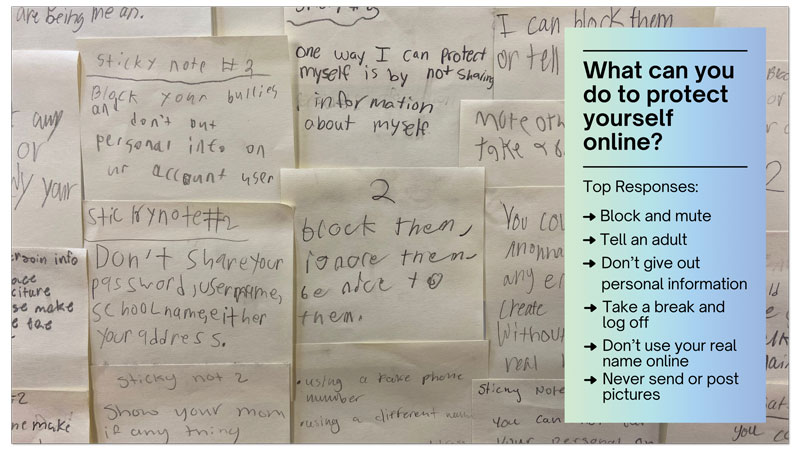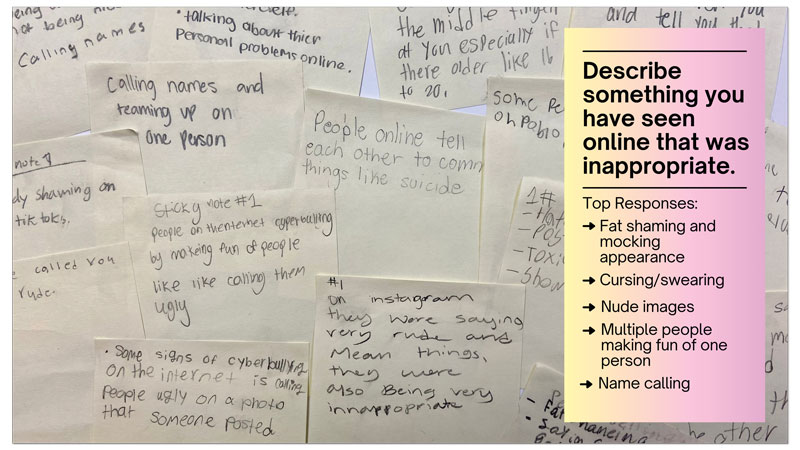2021 School Librarian of the Year Amanda Jones Creates Lesson About Navigating Social Media
After a student shared an upsetting incident on social media, Jones set out to teach her students about safely managing social media and ended up learning a lot herself.
 |
Some comments by studentsImages courtesy of Amanda Jones |
“Mrs. Jones, somebody told me on Instagram last night that they wished I’d die,” a 10-year-old student shared with me one day in the library. I was horrified.
My students range in age from 9 to 12. At any age, it would be overwhelming to see that on social media. I know from personal experience, having been the target of extremists for over a year now.
As an adult, it has been life-altering. I cannot imagine the impact on a child.
The conversation with that student made me curious about what else children are seeing online and how I can teach them to stay safe when navigating the internet. Our students are being barraged with hate from the devices in the palms of their hands. We need to be much more aware of our kids’ online lives and start focusing on how to help them navigate social media.
Share these online resources with parents and students |
I set out to design a lesson that would be a discussion, with opportunities for students to share their real-life experiences, draw on prior knowledge about internet safety, and walk away with more tools to help themselves.
It started with two prompts: Describe anything you’ve seen online that could be classified as bullying or hate, or share something inappropriate you’ve seen online; and What are several steps you can take to protect yourselves online? (We defined “online” as social media, YouTube, and gaming systems with internet connectivity.)
While displaying the prompts on a large screen, I gave everyone a sticky note for their anonymous answers. I asked the students to take time, sit, and reflect before answering. They placed the sticky notes on large posters—one for each question—in the front of the library.
I then read Nerdy Birdy Tweets by Aaron Reynolds. In the book, Nerdy Birdy gets swept up in the pitfalls of social media, much to the chagrin of his friend Vulture. Nerdy Birdy learns several valuable lessons about friendship and oversharing online.
My students said the story sounded all too familiar, although instead of the fictional platform Tweetster, their preferred social media tends to be Instagram and Snapchat.
According to terms of service for both platforms, users must be at least 13 years old. My students are not old enough, but nearly all have accounts. Very few said they are not allowed on social media. While some admitted to having accounts without parental permission, most said their parents know about their social media use. A few students told me that they have parental controls on their devices but know how to work around them. Most said their parents were not fully aware of inappropriate and upsetting comments and images they have been sent.
When asked if using Instagram and Snapchat was dangerous at their age, they all said yes. Next, we dove into their responses to the prompts from the beginning of the lesson. Answers to the question about bullying or inappropriate posts included:
• “Kids like to fat shame.”
• “I have seen racist comments a lot.”
• “Kids and adults will gang up on one kid and harass them over and over.”
• “There’s a man I don’t know who keeps asking me for my address.”
• “People ask me to send pictures that are bad.”

The most troubling comment was the abbreviation “KYS.” It appeared on more than 50 sticky notes, and I had no idea what it meant.
It stands for “kill yourself,” my students told me. Even more disturbing: Kids in each of the 27 classes in my school, totaling more than 650 students, said that they, too, have been told this online.
Interestingly, my own teen said that she sees “KYS” a lot in games with the older kids but doesn’t take it as bullying or a serious comment. The discussions we had in my lesson, however, led me to believe it was bullying. Many said a lot of kids pile up on one, telling them that over and over again. The younger kids see it as bullying and very mean, but it is notable to me that younger students and older students might view it differently.
When I asked my students how they could protect themselves online, they responded:
• “Tell an adult.”
• “Take a break from social media.”
• “Block and mute the person.”
• “Don’t give out personal information.”
• “Never post your picture.”
Amazing answers. But when pressed about whether they always follow their own advice, unsurprisingly, students admitted they do not. Most confessed to giving out personal information, posting pictures, and engaging with people who posted cruel or inappropriate comments instead of muting and blocking.
While they knew it was not worth engaging with internet trolls, my students all expressed how hard that can be, especially when they want to “save face” and seem cool. One told me that kids can get picked on even more if they don’t stand up for themselves. This was a good teachable moment about protecting our own peace, ignoring toxic online behavior when possible, and reporting to adults.
We brainstormed ways to be an upstander if they see someone else getting attacked online. We decided that leaving positive comments could help boost the self-esteem of kids being bullied, but students told me that they rarely do, because it draws the attention of the trolls. In the end, they agreed they had tough decisions to make when online.
I anticipated a short conversation, but it became an extended, deep, and earnest discussion. The kids were actively engaged. It was almost as if they had been waiting for an adult to ask them these questions. The discussion was honest and difficult—and eye-opening for me and their other teachers. The trauma these kids can face while simply playing a game online or chatting with friends on social media did not escape me. I wonder how this generation will be as adults navigating the internet. Will some become more empathetic after having faced such toxic behaviors at such a young age, or will they continue the pattern as they grow older?
To finish, students wrote down the biggest takeaway from the lesson on a graphic created by Laura Trapp, aka The Trapped Librarian (trappedlibrarian.org). I will hang these outside of the library to remind students about responsible digital citizenship.
Amanda Jones is a middle school librarian in Louisiana. She is the 2021 School Librarian of the Year.
RELATED
The job outlook in 2030: Librarians will be in demand
The job outlook in 2030: Librarians will be in demand
ALREADY A SUBSCRIBER? LOG IN
We are currently offering this content for free. Sign up now to activate your personal profile, where you can save articles for future viewing





Add Comment :-
Be the first reader to comment.
Comment Policy:
Comment should not be empty !!!